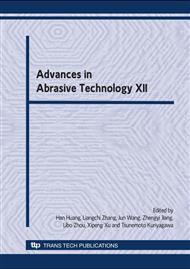p.169
p.175
p.181
p.189
p.195
p.201
p.207
p.212
p.217
Investigation of the Wear of the Pad Conditioner in Chemical Mechanical Polishing Process
Abstract:
The pad surface will become grazed because of the accumulated debris in the chemical mechanical polishing (CMP) process. It results in the reduction of the wafer removal rate, and a pad conditioner or diamond disk must be frequently employed to refresh the pad surface. The wear behavior of a diamond with respect to its location, original relative protruded height and protruded shape on a diamond disk was investigated in this thesis. It was found from experimental data that the diamonds which were located outside, originally protruded more highly and with crest lines oriented upward wore faster. Accordingly, four suggestions were proposed to obtain the uniform diamond wear. They are: lowering the protruded heights of the outside diamonds, replacing the current flat substrate by a curved surface substrate, changing the diamond distribution on the disk from the current uniform one to a higher concentration around outside diameter, and orienting the diamonds such that the flats are protruded upward for the outside diamonds and the crest lines are projected upward for the inside diamonds. Experiment had verified that the pad conditioner with center-protruded substrate led to a stable and higher dressing rate.
Info:
Periodical:
Pages:
195-200
Citation:
Online since:
June 2009
Authors:
Price:
Сopyright:
© 2009 Trans Tech Publications Ltd. All Rights Reserved
Share:
Citation:


